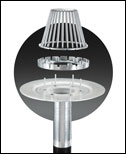Although all sectors of the building industry were affected by the housing downturn in late 2007, demand for roofing contractors has remained fairly steady. Most homeowners typically leave roofing projects to roofing professionals, and maintenance issues cannot be deferred indefinitely. Now that the construction market is growing, more opportunities are available—and you need to be prepared for the increased demand.
Marketplace shifts
As the construction market began to show signs of real recovery this year, the roofing industry benefitted from the uptick in demand. According to market research firm The Freedonia Group, Cleveland, the demand for roofing will have grown more than 2 percent throughout 2012. Driven by steady improvement in new construction activity, the residential construction market is projected to deliver the greatest roofing gains; however, the outlook for roofing demand in new nonresidential applications is also expected to improve. A majority of the demand for roofing work in 2012 will be from roof system replacements, according to The Freedonia Group's research. Additionally, repair work and preventive maintenance services will help keep roofing contractors and remodelers busy.
The success, safety and profitability of any roofing project depends on the management of time, labor and materials. The combination of the right tools and crew can make all the difference in delivering efficient and valued work. For any type of roofing work—from a simple repair job to new construction—there are universal best practices to follow when starting a new job. One of the things to consider is specialty parts and tools combined with the increased labor costs to pay experienced workers. Choosing between pneumatic versus cordless tools is one issue that should be addressed.
Pneumatic tools
Pneumatic nailers are roofing workhorses that can get a job, particularly a large job, done quickly. Pneumatic nailers have become lightweight, fast-driving, high-powered and accurate tools that can drive nails of varying lengths. Primarily used for production work such as new construction or roof system replacement, they allow roofing workers to quickly and precisely adhere base felt and shingles or tiles in record time. Ideal for applications where compressors are already in use and noise on the job site is not a hindrance, pneumatic roofing nailers can be found in almost every roofing worker's toolbox.
On large-scale roofing jobs, it makes sense for workers to use pneumatic nailers, hook up air compressors and fill pouches with nails to reload while on the roof. One thing to consider when using a pneumatic nailer is shingle blow-through and improper placement. Most roofing workers set the power level early in the day when the temperature is lower. As the temperature rises, the power level needs to be adjusted to avoid shingle blow-through.
Pneumatic tools also can be used when a roof structure needs to be strengthened, especially when replacing a lightweight roofing material (such as asphalt shingles) with a heavier roofing material (such as concrete tile).
Richard Bondarowicz, vice president of Smart Roofing Inc., Chicago, ensures his crews are equipped with pneumatic roofing nailers for every job.
He notes: "The use of pneumatic roofing nailers has not only improved productivity, it also, with proper use, has increased the overall quality of installation, as well as lessened the long-term negative effects on workers' bodies."
Cordless options
Roof system repair is serious business. The proper repair of modern roof systems frequently requires specialized knowledge, the application of new technologies and highly specific skills. When danger signs are identified, such as missing or cracked shingles, debris on the roof, clogged gutters and drains, severe weathering, curled shingles or fatigued roofing materials—or more ominous interior signs, such as leaks, damp areas and stains on ceilings—cordless roofing nailers may be a good option.
Cordless roofing nailers can be used for roof system repair; roofs for room additions, porches, garages or sheds; flashing application; skylight installation; drip edge and trim; ridge vents; and punch list items. Plus, productivity is improved from the time saved because there are no hoses to manage, no compressors to set up and put away, and no clutter on the roof. Having one hand free to carry materials and perform precision work further increases productivity.
Specific roof system repair jobs that work well with a cordless nailer include:
- A roof deck with loose boards and popped nails
- Shingles that have become loose or damaged from inclement weather or shingles showing signs of excessive drying, cracking and coating deterioration
- Visible cracks, open joints or questionable metal counterflashings
- Visible damage to base flashings, such as sagging, cracks and splits (depending on materials)
- Flashing applications and vent installations
- Ice damming leading to valley leaks
Despite common misconceptions that the only way to deliver craftsmanship on the job is to manually hammer and nail each shingle in place, roofing contractors are finding cordless tools can offer the same quality but in less time and with less strain on their bodies.
Matt Nelson, owner and president of Nelson Construction, Island Lake, Ill., has more than 25 years of remodeling and roof system repair experience and decided to give cordless tools a try for repair jobs, which make up a majority of his business. He found cordless tools save him time on the job and allow him to focus on the finish work, even when working in vulnerable places.
Nelson states: "In my business, it pays to be versatile and your tools should follow suit. Cordless tools offer a convenient solution that allows for one-person roof system repair without compromising craftsmanship. And without any concerns about stepping or slipping on a hose, I can better focus on the task at hand, even when I find myself in a trying spot on the roof, such as a dramatic sloped application. It is important to have a tool that can perform on a number of applications and doesn't require a lot of prep work."
Nelson also states he relies on his cordless system to complete more of the exterior finish work, most recently on a skylight installation and almost always on flashings.
He says: "I always strive to deliver quality work, and by going cordless I have more flexibility and maneuverability so that my finished product has actually been enhanced."
As contractors and remodelers begin to adopt cordless roofing nailer systems into their arsenal of tools, there are some drawbacks. Some roofing professionals consider the fact that cordless tools are better suited for repair work than large-scale production jobs as a drawback if a majority of their work is production-focused. Also, batteries on the tools must be charged every 2,200 shots, so a spare battery may be necessary. In addition, fuel cells need to be replenished after a period of use, which may create additional trips to the store or supplier. However, many current cordless users report their initial investment in a cordless tool pays off in labor and time saved on the job.
Tools for success
As the market continues to grow, housing values rebound, and homeowners become more optimistic and confident, maintenance work will increase. To help prepare for an influx of business, ensure crews have participated in the latest training, are up-to-date with the most recent materials and trends in roofing, and have clean tools and charged batteries. All these components can work together seamlessly for safe, quality and profitable roofing work in 2013 and beyond.
Jill Rosset is marketing manager for Paslode, a division of Illinois Tool Works Inc., Vernon Hills, Ill.
Benefits of cordless tools
Cordless tools offer several benefits over traditional pneumatic tools, such as:
- If you've been contracted for a repair job and the budget only allows for one person, a cordless tool is a good choice. With one hand free to lay the shingles and one hand to operate the nailer, a worker can complete a job quickly so you can turn a profit.
- Although you have pneumatic tools in your trucks, adding a cordless tool gives you added flexibility and versatility to tackle many types of exterior work.
- Cordless tools give workers more maneuverability on the roof so they are more sure-footed and don't have to worry about hose management.
- Homeowners may be home during roofing work. Cordless tools are quieter than the constant thrumming noise of air compressors.
- There are some misconceptions that a cordless nailer doesn't have the same power as a pneumatic nailer. But, for example, Paslode makes a cordless roofing nailer system that drives 2,200 nails per battery charge and is equipped to hold a coil of 120 galvanized roofing nails.



